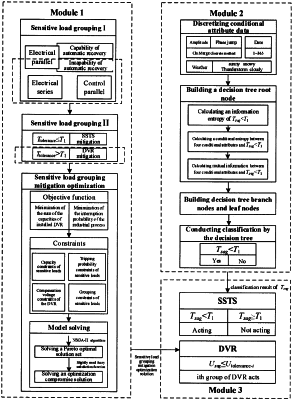| CPC H02J 3/0012 (2020.01) [H02J 2203/20 (2020.01)] | 4 Claims |

|
1. A method for formulating a coordinated action strategy of SSTS and DVR for voltage sag mitigation, comprising the following steps:
step 1: grouping mitigation of sensitive loads: considering a whole industrial process of a sensitive user, and realizing the grouping of two groups of sensitive loads of SSTS mitigation and DVR mitigation; conducting grouping optimization again for the sensitive loads with the installation of DVR for compensation and mitigation; and finally outputting a grouping matrix and grouping compensation voltage;
step 2: classification of voltage sag duration time: based on the characteristics of historical voltage sag monitoring data, constructing a decision tree to predict whether the duration time of a newly generated voltage sag event is less than SSTS switching time to conduct classification;
step 3: according to a grouping mitigation solution of the sensitive loads obtained in step 1 and the classification of the voltage sag duration time obtained in step 2, when voltage sag is monitored, formulating an action strategy of SSTS and DVR as follows:
if the voltage sag duration time is less than the SSTS switching time, SSTS switches load to a normal incoming line for power supply; otherwise, SSTS does not switch; and
if the amplitude of voltage sag is less than or equal to a minimum value of a voltage sag tolerance amplitude in a group of sensitive loads, DVR in the group of sensitive loads provides compensation voltage;
and controlling actions of SSTS and DVR according to the action strategy of SSTS and DVR in step 3, so as to realize voltage sag compensation; and wherein
the grouping mitigation of the sensitive loads in step 1 specifically comprises:
step 1.1: grouping the sensitive loads according to connection modes and function types of the sensitive loads in the industrial process, comprising:
S1-type sensitive loads: electrical series sensitive loads in which the sensitive loads are connected in series and would cause a sub-process to be interrupted when tripping;
S2-type sensitive loads: electrical parallel sensitive loads in which the sensitive loads are connected in parallel and would not cause the sub-process to be interrupted when tripping and would cause the sub-process to be interrupted when all the S2-type sensitive loads trip;
S3-type sensitive loads: control parallel sensitive loads in which the sensitive loads are connected in parallel and act on the industrial process through signal control, which are not directly set in the industrial process, but would cause a control process to be interrupted when tripping;
step 1.2: based on the above grouping, further conducting secondary grouping for each sensitive load:
1) dividing the S2-type sensitive loads into two categories according to whether the loads can recover automatically after suffering from voltage sag: sensitive loads capable of recovering automatically from voltage sag and sensitive loads incapable of recovering automatically from voltage sag;
2) dividing the S1-type and S3-type sensitive loads and the sensitive loads incapable of automatic recovery in the S2-type sensitive loads into two categories Ttolerance≤T1 and Ttolerance>T1 according to tolerant voltage sag duration time Ttolerance, wherein T1 is the SSTS switching time; the former is compensated and governed by installing DVR, and the latter is governed by SSTS switching lines;
step 1.3: conducting grouping optimization of DVR mitigation on the sensitive loads with the tolerant voltage sag duration time Ttolerance≤T1: a grouping goal is to install minimum-capacity DVR, and a governance goal is to achieve a minimum interruption probability of a sensitive industrial process of the user; therefore, a grouping optimization model of the sensitive loads is constructed by taking the minimization of the capacity of the installed DVR and the minimization of the interruption probability of the sensitive industrial process as an objective function, and decision variables are the grouping matrix and the grouping compensation voltage.
|